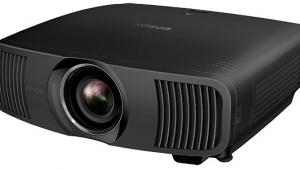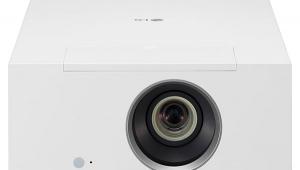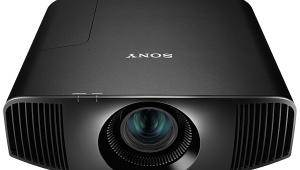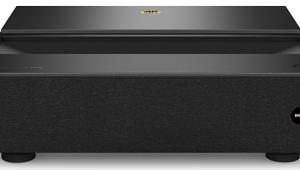Optoma HD8000 1080p DLP Projector

The projector we received for review, however, was the HD8000. At $3,199, the latter adds ISF day/night modes designed to be used by a custom calibrator and then locked so they cannot be tampered with. Apart from these the two projectors are functionally identical.
In For a Penny
All video processing is performed at 10-bits using video processing from PixelWorks. All the inputs are located on the back of the projector.
With two HDMI jacks plus a DVI connection, the Optoma has a more than generous complement of digital connections. It also sports a +12V trigger, and an RS-232 jack. And the HD8000 even has a Kensington Microsaver Lock Port to keep gnomes from running off with it—a unique feature (in my experience) for a home theater projector.
The lens zoom and focus are both manual. There is no lens shift feature, either vertical or horizontal, and the high throw angle means that for a perfectly rectangular image the projector needs to be mounted either below the bottom of the screen (a hassle for a table mount) or above the top of it (useful for a ceiling mount). Otherwise you will have keystone distortion. The HD8000 does have a keystone control to compensate for this, but we don't recommend keystone controls as they compromise resolution.
The HD8000 uses a 7-segment color wheel operating at 6x the video refresh (frame) rate. I found the Optoma somewhat less prone than average to the "rainbows" that afflict all single chip DLP projectors I've reviewed to one degree or another (I'm very sensitive to this artifact).
A large exhaust vent on the Optoma's right side not only pours out a lot of warm air, but also leaks light from the relatively small case, as well. The light leakage isn't bright enough to be obtrusive if the projector is located behind the viewing area, or is well above eye level, but both the light and the heat exhaust will need to be considered when deciding where to site the unit.
Optoma notes that the projector includes something called O2 {Jon: subscript the "2" if possible) Air Photo Catalyst air purification technology. This isn't explained exactly, but previous Optoma projectors have emitted a pungent odor that can become very unpleasant in a small, poorly ventilated room. Unfortunately, the HD8000 is no different, air purification or not. As of this writing our Optoma has about 35 hours on it. The odor is still there, but does appear to be less pronounced than when I first fired it up.

The most important image adjustments functions have direct access buttons on Optoma's excellent remote. All of the buttons are backlit, and the ones that don't have their function written in English on the buttons themselves have reasonably clear icons that specify their use.
The main video controls include the usual: Contrast, Brightness, Color, Tint, Sharpness, and Mode. There are five modes: Cinema, Brightness, TV, sRGB, and User. I stuck with User, and adjusted each control for the most accurate image possible.
There are also several Advanced controls: Noise Reduction, Gamma, and Degamma. The latter actually produces changes similar to that of the Gamma control, but with coarser steps. I set it on its Film option and left it there.
There's also True Vivid, a four-position control said to "enable the projector's vividness to be significantly increased." Edge Enhance does what its name implies. B/W Extension (not available on the HDMI or DVI inputs) stretches the black and white levels to "increase the contrast." And Color Temp provides selection of either Warm, Mid, Cold, or User. The latter offers full control (in the User menu) of red, green, and blue at both the high end (Gain) and low end (Bias) of the brightness range.
The Auto235 is designed to provide image stretch for use with an outboard anamorphic lens, but this has not yet been implemented (nor has a related control called Anamorphic Lens, which is also mentioned in the manual but similarly absent).
The HD8000 also has a 16-step, manually adjustable iris, Image AI, which is said to improve the contrast "by optimizing the brightness of the lamp according to picture content," and a Brite Mode for the projection lamp (Off is the best setting for video use).
The manual mentions a 48Hz control to display 1080p/24fps inputs at a 48Hz refresh rate, but that control has been omitted. Instead, the projector automatically recognizes when it receives a 24Hz input and frame doubles it to 48Hz with no user action required.
You can save separate video settings for each analog input, and a different setting for the HDMI and DVI digital inputs as well. But the HDMI settings are global across both HDMI inputs; you cannot save separate settings for HDMI 1 and HDMI 2.
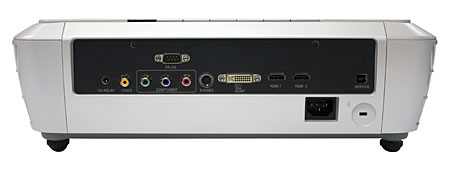
The Optoma is relatively quiet in normal operation, though no record setter. It's noisier in the Brite Mode, in the High Altitude setting, or with Image AI engaged, all of which increase the fan speed. But I never felt the need for any of those features.
Viewing
The HD8000's video processing is among the best I've seen. It's 480i-to-1080p upconversion was pristine on all of my standard deinterlacing/scaling tests, from the HQV Benchmark test DVD, where it earned mostly excellent results. It also passed the Gladiator test (chapter 12, the Coliseum flyover) and the pan across the rooftops at the beginning of Star Trek: Insurrection with nary a jagged edge.
On the HD side, it properly deinterlaced 1080i to 1080p with both video and film-based test patterns, and compensated correctly for 3/2 pulldown on the film deinterlacing test. It also passed our current favorite real-world test at either 1080p/60 or 1080p/24: the Vatican wall and steps in chapters 7 and 8 of Mission Impossible 3.
I did all of my viewing evaluations, apart from the test bench measurements of the component input, over HDMI.
Getting the best image out of the HD8000 proved a bit tricky. Beyond the fact that it would not reproduce below black (above white was fine), there are four controls that directly affect the Optoma's white and black levels: Brightness, Contrast, Iris, and Gamma (plus Degamma, which as noted earlier I left set on Film, Image AI, which I choose not to use, and B/W Extension, which is available only with an analog source).
Gamma generally affects the brightness of the image in the mid-brightness region, but in the Optoma it also somewhat affected the black and peak white levels as well. The best black level I was able to get (0.008fL on my screen, with a peak contrast of 1,911:1), was comparable to the results I have seen from other respectable but not state-of-the-art DLP projectors. But the settings that produced this result (Iris on 12, Gamma -1, Contrast 38, Brightness 53) resulted in an image that was lacking in punch through the mid-brightness region—even though the peak white level was more than adequate.
I finally settled on a different setup with the iris at its midpoint (see "Settings"). This resulted in a peak contrast ratio and black level that were merely adequate compared to the best displays we've seen recently. Nevertheless, it produced a satisfying compromise for all types of scenes—dark, mid-bright, and bright, with a punchy image on everything but the dimmest scenes with low intra-scene contrast.
Some of those dark scenes looked a bit gray, and shadow detail was not exceptional, but over a wide range of material these shortcomings weren't overly distracting. The climactic scenes in Disturbia (Blu-ray), for example, take place in a dark crawl space/basement. While you can see enough to know what's going on, thanks to the light from a flashlight, as viewed on the HD8000 the entire sequence is a bit grayed-out, with mediocre shadow detail. But this is a sequence that will challenge most digital displays.
Transformers isn't a classically pretty film, and its "look" is often heavily processed, with exaggerated whites and blacks (the latter sometimes looking a little crushed even on the best displays) and stylized colors. But it's been given a superb HD DVD video transfer (spectacular sound, too). It has a lot of dark scenes, but most of them have bright highlights that clarify details. Apart from shadow detail that's only fair at best, this film does not look grayed out on the Optoma; in fact it looks extremely good given the projector's less than amazing black level and peak contrast.
When I moved up to brighter images, the Optoma found even more solid footing and provided impressive performance. A Knight's Tale Blu-ray transfer was underappreciated when it was released, coming as it did in the very first, much criticized batch of Blu-ray discs. It has a few difficult dark scenes, most of it is brightly and beautifully photographed. And for the most part it looked outstanding on the Optoma—sharp, crisp, and dimensional, with clean, unexaggerated color.
While high-definition certainly looked good on the HD8000, the projector didn't skimp on good standard def DVDs, either. Kenneth Branaugh's Hamlet is a transfer we'd all have been raving about two years ago, but even without HD chops it was impressive on the Optoma. The bright scenes popped with good SD detail and bright colors, and even the dark scenes (few of which are truly challenging, it must be said) looked good.
Back to high-definition, Pirates of the Caribbean: The Curse of the Black Pearl is arguably the best-looking Blu-ray disc yet released. And it never looked less than good on the Optoma in its well-highlighted dark scenes, and often spectacular in its brighter ones. As I watched it on the last day of testing, and it was difficult to tear myself away from the experience to finish the review!
Conclusions
When set up for the best looking, best balanced picture it was capable of, the Optoma's black level and peak contrast ratio were no better—and perhaps a bit worse—than the best single-chip DLPs of three years ago. But those projectors then cost three times the current price of the HD8000.
Many projectors that compete with the Optoma on price rely on dynamic irises to achieve good blacks. The Optoma can't match those blacks, but neither does it involve the compromises some viewers find in an auto iris.
When properly calibrated, the Optoma drew me in with its crisp, punchy images. Can you do better? Yes—for a lot more money. If you're looking for a good buy in a home theater projector, give the HD80 or HD8000 a close look.
Highlights
Punchy, sharp image
Excellent video processing
Good price








